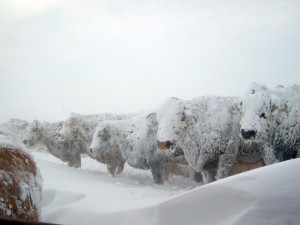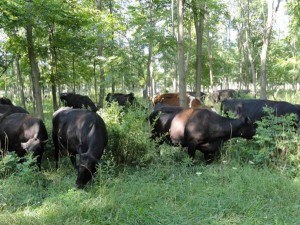Juan P. Alvez | Pasture Technical Coordinator, Center for Sustainable Agriculture – UVM Extension
Livestock animals can bear cold weather. But even if we want to extend the grazing season, keeping our animals outside, as much as possible, there are some kinds of cold weather that we must pay very careful attention to. When it comes to protecting our animals’ health and ensuring their productivity it is important to know a few facts.

Fig. 1. Limousin Beef Cattle at Venner Farm, IA. Excellent body condition is key.
(http://vennerlimousin.com/about/are-your-cows-this-tough/)
Extreme winter has not been a major concern for Vermont (and Northeast) livestock farmers because, in general, cattle can tolerate the elements … unless two primary circumstances are present: (1) poor body condition and, (2) wet, windy weather with subzero wind chill temperatures (Fig. 1).
Cattle livestock endure ‘comfortably’ in temperature ranges between 0C (32F) and 24C (74F). Production does not get significantly affected in this temperature range as long as they have sufficient hay, feed and water to keep their body condition. Unlike the weather, fortunately this is something farmers can control.
On the other hand, relative humidity plays a big role during degraded weather circumstances. Animals will suffer greatly (and you will notice!), when extreme temperatures are accompanied by wet and windy conditions. Thus, extreme cold weather can take a toll on your herd, particularly taking down animals with previous health problems, or the ones that don’t have at least periodic access to enough food and/or a shelter.
What can farmers do?

Fig. 2. Wooded pastures or silvopasture (an agroforestry practice where cows graze under trees), are great shelter alternatives for cows enduring cold or warm weather.
In extreme cold like much of the northern US is currently experiencing, if proper facilities exist, animals should be guarded and sheltered indoors (e.g. barn). A bedded pack barn, is probably the best alternative for that.
However, if you chose to keep them outside, please plan ahead of the bad weather and establish a “forest barn” in a wooded pasture area (Fig. 2). If we assume that most of the cold comes from above (cold air is heavier than warm), and that animal heat is thinner and escapes, then covering your animals is a good idea.
Cows compensate temperature differences with a ‘coat’ for every season and they can generate metabolic heat, and heat from movement. If cold, these gregarious animals will flock together and alternate places and benefit from the heat exchange released by the herd. Animals in the outer circle will try to find a warm spot and ‘force’ themselves into the center, pushing the ones in the inner (Fig. 3).
If your farm doesn’t have facilities that can accommodate your animals, it may not be a bad idea to build a rustic shelter (perhaps adjacent to the forest barn), re-using inexpensive tarps and rope (Figure 3).
Always keep enough bedding in the barn or in the woods, so that cows can lay down in a relatively dry spot. If your cows are in a “forest barn”, try changing the areas where they stay periodically, to avoid erosion and nutrient runoff during the ‘mud season’.
Temperature Humidity Index (THI)
In hot weather, monitor temperature and appetite. Take note of the Temperature Humidity Index (THI), an equation that indicates that when relative humidity at a given temperature increases, then comfort factor decreases. For example, if temperature is around 92 and relative humidity is 85, THI should read 89, which is almost borderline for severe stress. However, in dairy cows, milk production starts being affected when THI reaches beyond 78. (See chart).
In sum, yes, beef cattle can withstand subzero temperatures for a few days but, they may die (or significantly lower production), if they present poor body condition and wet, windy low temperatures bump into them.
Take-Away Ideas
- Be aware that animals whose general health is poor may need special attention to survive or remain productive during extreme weather conditions.
- During temperature extremes, take special care that your animals have access, at least periodically, to shelter and adequate feed.
- If the temperature is below 32F or above 74F, consider providing your herd shelter in a barn, Bedded Pack barn, or “Forest Barn” in a wooded area.
- Remember, cold air is heavier than warm air and mostly comes from above so, protect your animals and stay ahead in production!
Sources:
Dr. Frank Wiersama, 1990. Dept. of agricultural Engineering. Univ. of Arizona. http://www.heatstress.info/heatstressinfo/TemperatureHumidityIndexCattle/tabid/1232/Default.aspx
Venner Farm, IA. http://vennerlimousin.com/about/are-your-cows-this-tough/



Recent Comments